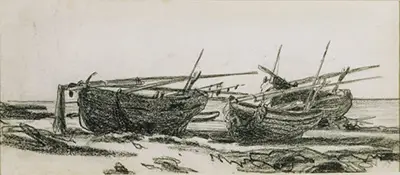He also embraced the use of bright and vibrant colours within many of his works. Some notable examples include Woman in a Garden, Springtime and Water Lilies.
However, a handful of his most cherished pieces were actually drawn as sketches and in a black-and-white motif. One such piece is entitled Boats on a Beach at Normandy. What does this sketch tell us about the thought processes of Monet as well as his talents as an artist?
Many believed that Monet was unique in the fact that drawings rarely comprised the early stages of his paintings. However, this myth has been somewhat dispelled. Beginning in the 1880s, Monet began to abandon urban settings for the more rural environments that were found throughout France.
It is thought that he was particularly fond of the northern coast due to its stark cliffs and rocky shores. Towns such as Normandy and Étretat were therefore some locations which featured in his work during this period.
Historians have noted that Monet regularly carried a sketch book along with him during his travels. He would use this tool as a means to visually outline ideas for future projects; only to later "flesh" them out using other techniques. Both pastels and charcoal were employed during such instances.
Finished works of pastel were often given as presents to friends while his lesser-known charcoal studies tended to remain private, as did some of his pastels. These were more practical in their nature and even somewhat architectural in their appearance. Indeed, Monet himself considered such works to be little more than ideas which never came to fruition.
It is for this reason that he made no attempt to publicise pieces such as Boats on the Beach at Normandy during his lifetime. It was only after his death that such oeuvres were discovered, and to great fanfare. These showed the internal mechanisms of Monet as an observer and offered a tantalising window into the formative processes involved before he placed a brush to canvas.
Boats on a Beach at Normandy is but a single example of the types of sketches that Monet produced during this time period. Some contemporary analysts have noted that a certain amount of visual chaos tends to reign within these works.
This would actually make perfect sense, as Monet was more concerned with capturing an image in time as opposed to refining it for public viewing. Such aspects can clearly be seen in this work. However, it is important to note that key elements such as perspective and dimension are nonetheless extremely accurate.
This illustrates the mastery with which Monet was able to take a black-and-white "snapshot" in time and space. Such realism also makes us wonder if Boats on a Beach in Normandy would require any further refinement (Edward Hopper remains one of the most famous Realism artists). The lack of colour presents us with a stark and even foreboding sentiment. Boats delineated by an entirely blank and unknown horizon certainly leave an emotional impression on the viewer.
Of course, these observations are due in no small part to the history of Normandy and the beach landings during the Second World War. This work is unique in the fact that it is able to capture a more traditional time when conflict was still hanging somewhere on that distant and obscure horizon.


